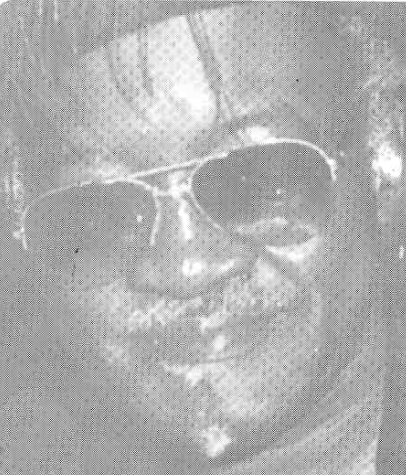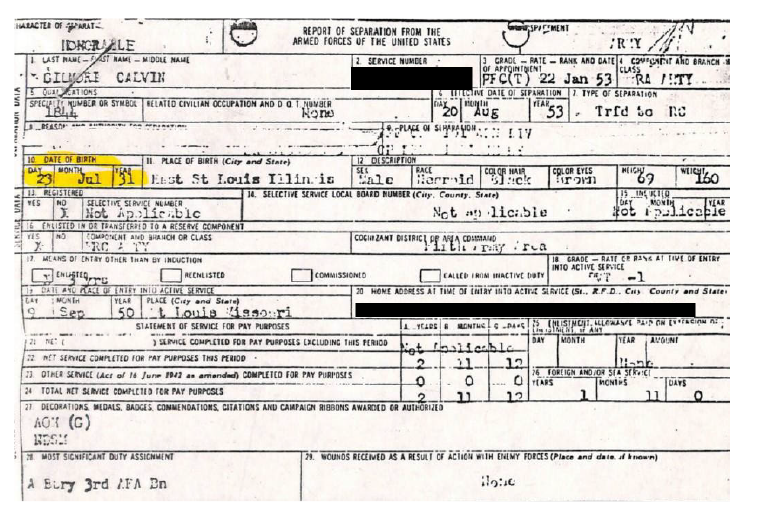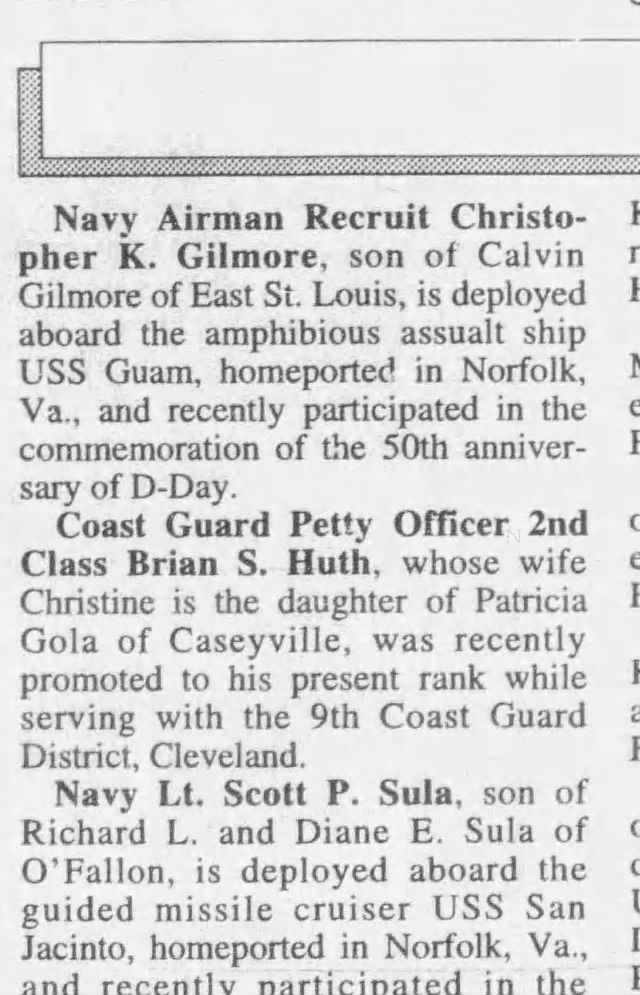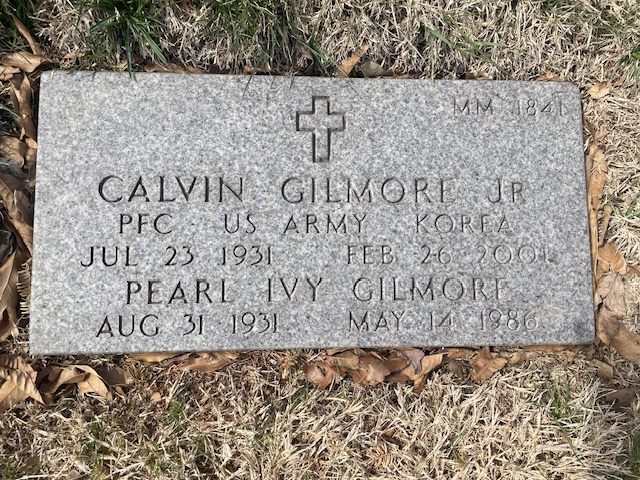Private First Class Calvin Gilmore

- Unit: Battery A, 3rd Armored Field Artillery Unit
- Date of Birth: July 23, 1931
- Entered the Military: September 9, 1950
- Date of Death: February 26, 2001
- Hometown: East St. Louis, Illinois
- Place of Death: East St. Louis, Illinois
- Award(s): National Defense Service Medal
- Cemetery: Section MM, Site 1841. Jefferson Barracks National Cemetery, St. Louis, Missouri
Mentored by Dr. Megan Burian
Marquette High School
2024/2025
Early Life
Calvin Gilmore was born on July 23, 1931, in East St. Louis, Illinois. His father, Carroll, was from Mississippi, and his mother, Jeanette, was from Illinois. Neither of his parents attended high school, and his father worked as a laborer. He had four siblings, three sisters and one brother. The family lived together until after 1940. His parents divorced sometime between 1940 and 1950.
Gilmore attended one year of high school, likely in East St. Louis, Illinois. According to records from the U.S. Railroad Retirement Board, he later attended one year of business school.


Homefront
East St. Louis, Illinois, was founded in 1865 across the Mississippi River from St. Louis, Missouri. East St. Louis was an industrial town through the 1960s, with steel, coal, and glass factories. Heavy rail traffic flowed through the area, drawing and sustaining industries like steel and ore.
Height of East St. Louis
East St. Louis was the center of culture and industry, producing icons like Miles Davis and Katherine Dunham. The city grew to 81,950 people by 1950. It was the fourth-largest city in Illinois at this time. East St. Louis was given the All-American City award in 1959 from the National Civic League, which recognizes cities that use civic engagement to address critical issues and create good connections in the community.
Struggles of the city
East St. Louis has a history of racial struggles, most notably with the 1917 East St. Louis Massacre, referred to in earlier histories as the East St. Louis Race Riot. This event was rooted in labor disputes at the Aluminum Ore Company, a major employer in the area. Workers, who were primarily White, went on strike, and Black men were hired to take their place.
Unrest and rumors quickly escalated the tense situation, leading to days of extreme violence with beatings, lynchings, shootings, and fires. Dozens, possibly hundreds, died during the massacre, with significantly more Black residents killed and injured than White residents. Many Black residents fled the city across the bridge to St. Louis, Missouri, never to return.
Despite its eventual rise to All-American City in 1959, the second half of the twentieth century saw East St. Louis decline to an economically struggling city with a dwindling population. Relocations or closings of major industrial companies in the 1960s and 1970s impacted the city dramatically. As the industry left, so did the jobs and the residents. Movie theaters and other amenities closed in the last decades of the twentieth century as people moved out of the area.


Military Experience
Calvin Gilmore enlisted in the U.S. Army on September 9, 1950, in St. Louis, Missouri. He was assigned to the Fifth Army Area.
Private First Class Gilmore was in the field artillery branch. His job code of 1844 applied to several different jobs in artillery. He served just short of two years in foreign service, although the records regarding the specifics of his service were lost in a records fire in St. Louis, Missouri.
Achievements
Gilmore achieved the rank of private first class. Of all his tasks, his most notable duty assignment was to the A Battery, 3rd Armored Field Artillery Unit. He received the National Defense Service Medal and an honorable discharge from the Army on August 20, 1953.

Veteran Experience
Despite the challenges in East St. Louis, Mr. Gilmore returned there after his three-year enlistment ended. He married Ms. Pearl Ivy Smith, and together, they had ten children who were also raised in East St. Louis.
Even after the death of his first wife, Pearl Ivy, Gilmore remained tied to his home of East St. Louis when he met and married Ms. Helen Mayes, who was also from East St. Louis. They were married on January 6, 1989, by Reverend William H. Montgomery, a Baptist Minister. Mrs. Helen Gilmore passed away on November 1, 1996, at the age of 62, of lung cancer.
Work
After holding a position as a sheet metal worker for McDonnell Douglas Corporation, Gilmore worked for the railroad in 1969 and remained there until he retired in 1991. He dedicated himself to the physically demanding work of a laborer and switchman for the Alton and Southern Railroad. His jobs often required endless hours on his feet, walking, and climbing while working with heavy tools.
Looking back on his job as a switchman, he described his duties as consisting of “coupling a certain amount of tracks and setting out different type cars . . .” His positions were often dangerous and complex, with exposure to “hazardous material such as nitric acid, [vinyl] chloride (A)(B) explosives, helium, nitrogen, oxidizers, chlorine . . .”
Family
One of Gilmore’s sons served in the U.S. Navy, and one of his daughters in the U.S. Air Force. In addition, he was an active member of the only all-Black VFW post in East St. Louis.


Commemoration
Calvin Gilmore died February 26, 2001. He is buried at Jefferson Barracks National Cemetery in St. Louis, Missouri.
He left behind children, grandchildren, and great-grandchildren to serve as witnesses to his life of work in service to his country. He is buried at Jefferson Barracks National Cemetery, St. Louis, Missouri.

Bibliography
Primary Sources
Calvin Gilmore. Abridged Record. United States of America Railroad Retirement Board. National Archives and Records Administration – Boston.
Calvin Gilmore Jr., DD-214, Department of the Army. National Archives and Records Administration – St. Louis.
Illinois. St. Clair County. 1950 U.S. Census. Digital images. http://ancestry.com.
“Military News.” Belleville News-Democrat [Belleville, IL], July 10, 1994. Newspapers.com (160904013).
Missouri. St. Clair County. 1930 U.S. Census. Digital images. http://ancestry.com.
Missouri. St. Clair County. 1940 U.S. Census. Digital images. http://ancestry.com.
Missouri. St. Clair County. 1950 U.S. Census. Digital images. http://ancestry.com.
“Mr. Calvin J. Gilmore.” Officer Funeral Home. Accessed September 20, 2024. https://www.officerfh.com/obituary/5576718.
View of the Railroad Yards, East St. Louis, Ill. Postcard. Virtual East St. Louis Historical Society. Southern Illinois University Edwardsville. https://www.siue.edu/artsandsciences/political-science/about/iur/projects/eslhistory/galleries/index.shtml.
Secondary Sources
“America’s most livable cities: Past winners.” National Civic League. Accessed November 5, 2024. https://www.nationalcivicleague.org/america-city-award/past-winners/.
Barnes, Harper. Never Been a Time: The 1917 Race Riot That Sparked the Civil Rights Movement. Walker & Company, 2008.
“Calvin Gilmore, Jr.” Veterans Legacy Memorial, U.S. Department of Veterans Affairs. Accessed March 4, 2025. https://www.vlm.cem.va.gov/CALVINGILMOREJR/728E78E.
“Calvin Gilmore.” National Cemetery Administration. Accessed September 13, 2024. https://gravelocator.cem.va.gov.
“Calvin Gilmore, Jr.” Find a Grave. Last modified April 15, 2007. Accessed October 1, 2024. https://www.findagrave.com/memorial/18950381/calvin-gilmore.
“Cheryl Ann Curtis.” Find a Grave. Last modified August 24, 2016. Accessed November 30, 2024. https://www.findagrave.com/memorial/168905493/cheryl-a-curtis.
“The East St. Louis Riot.” PBS. Accessed November 16, 2024. https://www.pbs.org/wgbh/americanexperience/features/garvey-riot/.
“East St. Louis History Timeline.” Southern Illinois University Edwardsville. Accessed November 5, 2024. https://www.siue.edu/artsandsciences/political-science/about/iur/projects/illinoistown/timeline.shtml.
Gangreco, D.M. Korean War Anthology: Artillery in Korea: Massing Fires & Reinventing the Wheel. U.S. Army Command and General Staff College, 2006. https://apps.dtic.mil/sti/pdfs/ADA453946.pdf.
“Information about our city.” City of East St. Louis. Accessed November 5, 2024. https://www.cesl.us/247/Information-About-Our-City.
Keyes, Allison. “The East St. Louis Race Riot Left Dozens Dead, Devastating a Community on the Rise.” Smithsonian Magazine, June 30, 2017. https://www.smithsonianmag.com/smithsonian-institution/east-st-louis-race-riot-left-dozens-dead-devastating-community-on-the-rise-180963885/.
May, Lee. “All-but-Dead City: E. St. Louis: Hope Amid Hopelessness.” Los Angeles Times [Los Angeles, CA], September 15, 1986. https://www.latimes.com/archives/la-xpm-1986-09-15-mn-11782-story.html.
Nunes, Bill, and Andrew Theising. Images of America: East St. Louis. Arcadia Publishing, 2011.
This profile was funded by a grant from the United States Department of Veterans Affairs. The opinions, findings, and conclusions stated herein are those of the author and do not necessarily reflect those of the United States Department of Veterans Affairs.

